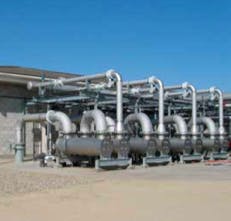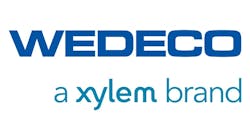Clovis is a city with a population of around 97,000 in Fresno County, Calif. The city is 6.5 miles northeast of downtown Fresno. Until the early 1970s, groundwater was the sole water source for the residents of Clovis. Well water was used for irrigation and industrial use, as well as drinking water. As the population grew in Fresno County, ground water levels dropped and wells began drying up. To meet the growing water needs, the city of Fresno decided to recycle water being processed at its wastewater treatment facilities.
Solution
The Clovis City Council approved construction of a new state-of-the-art water reuse facility in 2001. The facility began operation in 2009.
The goals for the water reuse facility are to:
• reduce reliance on groundwater sources from 28 to 18 percent of total consumption,
• create a tertiary treatment system with multistage treatment and filtration,
• treat wastewater to high quality reuse standard, and
• use recycled water for irrigation and recreation (which is estimated to account for 5% of the city’s demand by 2010 and 13% by 2020).
These goals are aligned with the philosophy that every drop of recycled water used for irrigation or industrial purposes is a drop of precious drinking water saved.
The design capacity of the facility is 5.6 mgd (883 cu m/hour). The high-quality treatment water is produced to meet the requirements of California’s stringent Title-22 regulations.
The selected treatment process includes a membrane bioreactor (MBR), an ultraviolet (UV) disinfection system and a two-stage solids reduction process, all with automated control and remote monitoring. As the UV disinfection step is right after the MBR, a closed-vessel UV system was required to avoid interrupting pressure.
UV was selected for disinfection, as it provides pure and safe chemical-free water without any toxic byproducts. During the selective bidding process, both medium- and low-pressure, high-output lamp systems were evaluated based on capital and projected ten-year lifecycle costs. WEDECO’s low-pressure, high-output LBXe UV system was selected due to highly efficient lamp technology that consumes roughly a third the energy of medium-pressure lamp systems and, additionally, provides the benefit of longer lamp life.
Result
WEDECO’s UV equipment was shipped to the site and started up in December of 2008—one year after construction began. Since commissioning the WEDECO UV system, the LBXe reactors have performed in full compliance with California’s Title-22 standards.
WEDECO’s long experience with the sensor-based OptiDose control offers additional energy savings and ensures the required dosage is applied while conserving power and lamp life.
The Clovis facility experienced low maintenance with WEDECO’s UV system, requiring minimal operator involvement. Energy consumption is continuously minimized at all operating conditions with WEDECO’s OptiDose sensor-based control system. OptiDose utilizes an ÖNORM-compliant UV sensor for active monitoring of UV performance. The sensor input automatically adjusts UV lamp output to the meet the required 80 mJ/sq cm NWRI dose. Meanwhile, the LBX automatic sleeve-cleaning system maintains maximum sleeve transmittance for peak UV output. By keeping the sleeves clean, the system uses less energy and lowers operational costs. The superior effectiveness of the WEDECO mechanical cleaning system has been proven in thousands of installations around the world.
“The City of Clovis Water Reuse Facility is a great representation of the commitment the city has shown to the environment and its citizens, and it is a great model for other communities who are grappling with issues of surface and/or groundwater shortages,” said Steve Patterson, P.E., CH2M HILL principal project manager.
At its maximum capacity, the Clovis Water Reuse Facility will be able to produce over two billion gallons (or 6,200 acre-ft, or 7.7 billion L) of water per year. This amount of recycled water is equivalent to the total water used by 14,000 homes every year.
As many of America’s water supplies are diminishing, more cities and counties are turning to the use of safe, reliable alternative water sources. Xylem has been a long-time advocate and supporter of the practice of using recycled water for non-potable applications, and many of Xylem’s products make this process reliable and cost-effective.



